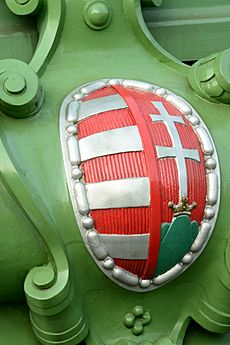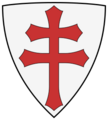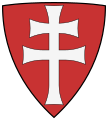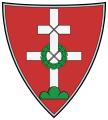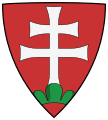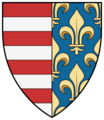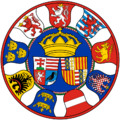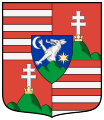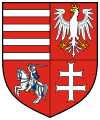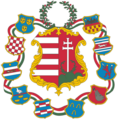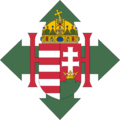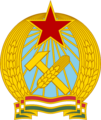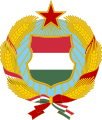Coat of arms of Hungary facts for kids
Quick facts for kids Coat of arms of Hungary |
|
|---|---|
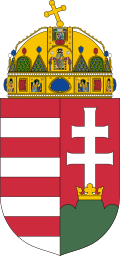 |
|
| Versions | |
 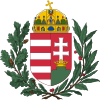
The coat of arms may also be used in other historical forms.
|
|
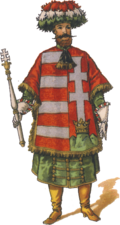
Herald’s tabard
|
|
| Armiger | Hungary |
| Adopted | 3 July 1990 |
| Crest | Holy Crown of Hungary |
| Blazon | Barry of eight Gules and Argent, impaling Gules, on a trimount Vert a ducal coronet Or issuing therefrom a Patriarchal cross Argent |

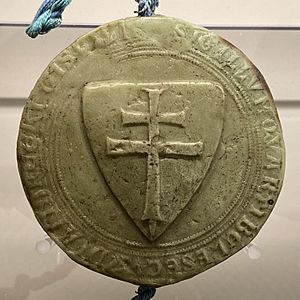
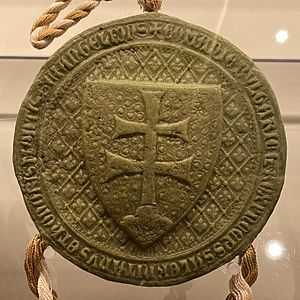
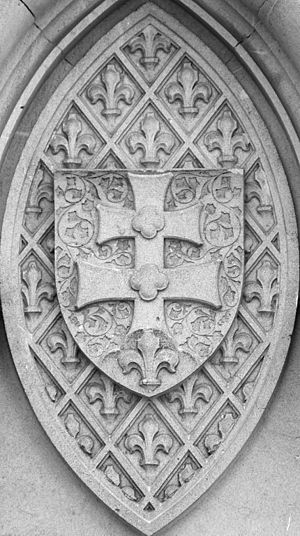

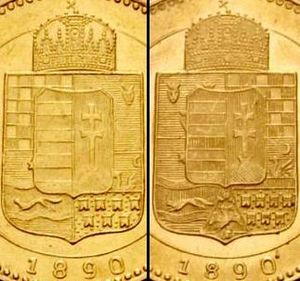
The coat of arms of Hungary is the official symbol of the country. It was chosen on July 3, 1990. This happened after Hungary stopped being a communist country. The coat of arms has been used for a long time, even in the Middle Ages. Sometimes it was used with the Holy Crown of Hungary, and sometimes without it. It has also been part of bigger, more complex coats of arms.
The main shield of the coat of arms is split into two parts:
- The right side (called dexter in heraldry) has four red and four silver stripes. These are known as the Árpád stripes. People traditionally say the silver stripes stand for four important rivers: the Duna (Danube), Tisza, Dráva, and Száva.
- The left side (called sinister) shows a silver double cross. This cross is on a red background. It sits inside a small golden crown. This crown is placed on the middle of three green hills. These hills represent three mountain ranges: Tátra, Mátra, and Fátra.
On top of the shield, you can see the Holy Crown of St. Stephen. This crown belonged to King Stephen I. Today, this important crown is kept safe in the Parliament building in Budapest.
Contents
History of the Hungarian Coat of Arms
Early Symbols of Hungary
In ancient times, symbols like the griffin, wolf, and deer were common. But they rarely appeared in later Hungarian symbols. The hawk, or Turul, was different. It was a special bird in old stories. It was believed to connect the earth, sky, and underworld. This bird stayed as a symbol for the ruling family for a longer time.
Medieval Hungarian Symbols
The first known symbol of Hungary was a red double cross. This was shown in a book from the 15th century. It represented Hungary during the time of Saint Ladislaus I.
The red and white stripes became a symbol for the Árpád dynasty in the 13th century. They first appeared on a seal in 1202. This seal belonged to King Emeric. It only had stripes, no double cross. There were also nine golden lions on the red stripes.
Later, in the Golden Bull of King Andrew II, there were seven lions. These lions faced each other. Linden leaves were also shown in the middle of the stripes.
The white double cross first appeared on coins around 1190. These coins were made during the rule of King Béla III. It was first seen on a shield on the royal seal of King Béla IV around 1235.
The green three-hill symbol was used with the double cross. This appeared on the seal of King Stephen V (1270–1272). His seal also had a wreath around the double cross.
The seal of King Wenceslaus III (1301–1305) also showed the simple double cross with the three hills.
Changes with New Royal Families
When the Árpád family line ended, the Angevin family took power. They wanted to show they were the rightful rulers. So, they used the Árpád family's red and white stripes. King Charles I combined these stripes with the Angevins' fleur-de-lis symbol.
King Louis I later combined the red and white stripes with the double cross and three hills. This design was also used by John Zápolya. He added his own family's arms in a small shield in the middle.
The two main symbols, the stripes and the cross with hills, were often shown side by side. They were first combined on coins during the rule of King Vladislaus I (1440–1444). Later, they appeared on coins of King Matthias Corvinus (1458–1490).
The crown above the coat of arms also appeared during Vladislaus I's rule. At first, it was just a simple crown. But on Matthias Corvinus's seal in 1464, it looked more like the Holy Crown of Hungary.
The modern version of the coat of arms developed in the early 17th century. This happened during the rule of King Matthias II. It became commonly used during the time of Maria Theresa.
The Coat of Arms in the 19th Century
During the Hungarian Revolution of 1848, the Holy Crown was removed from the coat of arms. This happened after the Habsburg family was removed from power in 1849. This crown-less coat of arms is called the "Kossuth Coat of Arms." It is named after Lajos Kossuth, who was a leader at the time. In larger versions, a laurel wreath replaced the crown.
Over the next centuries, the coat of arms became more complex. It included symbols of other lands that were part of Hungary. These included Croatia, Dalmatia, and Slavonia. But the "small coat of arms" always stayed the main part. More complex versions were called "medium" and "large" coats of arms.
After the Austro-Hungarian Compromise of 1867, the small coat of arms with the crown became part of a more complex design. This was similar to the medium coat of arms. The Hungarian arms also became part of the combined coat of arms of Austria-Hungary.
Changes in the 20th Century
Coat of Arms After World War I
After World War I, Hungary became the First Hungarian Republic. A new coat of arms was introduced. It was very similar to the "small coat of arms." However, symbols of the monarchy were removed to make it look more like a republic.
In 1919, the Hungarian Republic of Councils completely removed the old coat of arms. They used a communist five-pointed red star on official papers. After the communists fell, the Kossuth coat of arms was used for a short time.
Coat of Arms During and After World War II
After the kingdom was restored, the small coat of arms became official. It included the Holy Crown and two angels. This was used until 1938. Then, the government started using the 1915 coat of arms again.
During World War II, Nazi Germany occupied Hungary. A government formed by the Arrow Cross Party added the letter "H" (for Hungaria) and the Arrow Cross symbol to the coat of arms.
After the war, the Red Army defeated the Nazi forces in Hungary. This led to a communist government being formed. Between 1946 and 1949, the Kossuth-style coat of arms was used. Then, the Hungarian People's Republic introduced a new state coat of arms. This new design looked very similar to the coat of arms of the Soviet Union.
Coat of Arms During the 1956 Revolution
During the Hungarian Revolution of 1956, the "Kossuth" Coat of Arms was used again. In old news videos, you can see the Kossuth badge painted on tanks fighting the Soviet invasion in Budapest. Even though the Soviets quickly stopped this revolution, the new communist government did not bring back the 1949–1956 coat of arms. So, the Kossuth coat of arms was used for about a year.
A new coat of arms was created in late 1957. It had a more traditional shield with the Hungarian red-white-green colors. This was placed inside the communist-style wreath and red star. This coat of arms was used until 1990.
The Current Coat of Arms
Since 1990, the historical crowned small coat of arms has been the official symbol of Hungary. When the first democratically elected Parliament met, there was a big discussion. Some people wanted the Kossuth-style "Republican" version. But the government supported the historical, crowned one. In the end, the historical version with the crown was chosen.
Special Stamps and Coins
- In 1946, a set of eight stamps showing the Coat of Arms of Hungary was released. These were part of a time when money was losing value quickly.
- Also in 1946, a set of fourteen stamps with arms and a post-horn was issued. These were also from the time of high inflation.
- Four special stamps were released on March 15, 1948. They were part of a series celebrating 100 years since Hungary's fight for independence began.
- On August 20, 1949, three stamps with the Arms of Hungary were issued. This was to celebrate the new Constitution of the Hungarian People’s Republic.
- On May 23, 1958, three stamps were issued. They marked one year since a law changed the constitution.
- Between 1941 and 1945, many Postage-Due stamps were issued. These were for collecting extra postage money.
See also
 In Spanish: Escudo de Hungría para niños
In Spanish: Escudo de Hungría para niños
- Coat of arms of Slovakia
- Coat of arms of Budapest
- Hungarian heraldry
Images for kids


